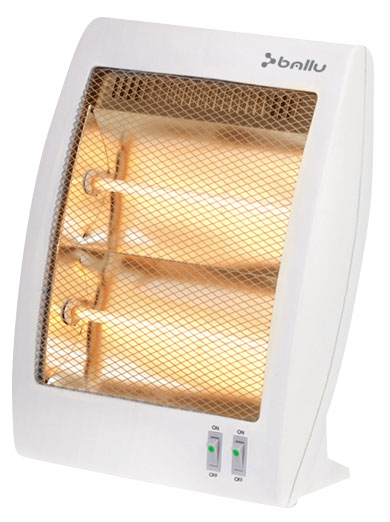Ceramic heaters: pros and cons
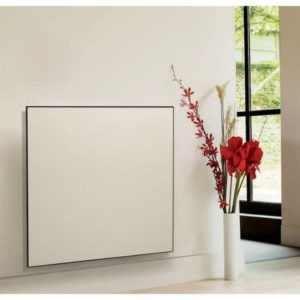 Among the many types of heaters on sale, modern ceramic panels are worthy of attention. They have been implemented for several years; all the advantages and disadvantages have been identified during practical operation.
Among the many types of heaters on sale, modern ceramic panels are worthy of attention. They have been implemented for several years; all the advantages and disadvantages have been identified during practical operation.
The devices have increased efficiency thanks to the innovative design, which consists of a combination of two types of heating: infrared radiation and convection.
The design is supplemented with details that increase comfort of use and save energy consumption.
The content of the article
Operating principle of ceramic heaters
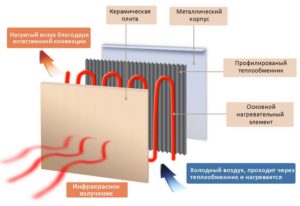
In the first year of its appearance on the market, consumers were struck by the novelty of the development.
All devices offered before have different efficiencies, but have a common drawback. Heating of the room stops immediately as soon as the heat source is turned off. Ceramic heaters continue to give off heat even after being turned off.
Important! The operating principle is based on a combination of infrared radiation and convection of heated air.
Since ancient times, a similar principle has been used in village huts heated by Russian stoves. The stove was heated, and it still gave off heat to the environment for a long time.It was placed in the center of the hut so that it opened into all rooms. The surface that gives off heat was made as large as possible, covering the entire wall.
Thanks to natural convection, air movement occurred. As the air warmed up, it moved upward, giving way to cold air. Having moved further from the heated wall, it cooled down and sank down. Circulation occurred continuously until the oven itself cooled down. Due to the high heat capacity of the stove, provided by the mass and materials, it was enough to heat it once a day.
Important! Due to the high thermal capacity of ceramic panels, they give off heat after the heating source is turned off.
Creating a comfortable temperature in a room heated by ceramic heaters occurs as follows.
- Ceramic plates with high heat capacity are heated. Modern industry offers more than one type of ceramics. For the panels, a material with optimal porosity, hardness and density indicators was selected. Reflectors convert heat into infrared radiation.
- After reaching a certain temperature, the heating turns off, but the plates continue to heat the surrounding air, giving off heat to it and gradually cooling down.
The process is accompanied by natural convection, due to which the room is heated evenly. - When the temperature of the ceramic reaches a certain minimum, the heating is turned on and the process is repeated.
Different device models use different heating sources and thermoregulation. The effect is enhanced by forced convection using a fan. The heat capacity can be greater or less due to the size and thickness of the plates.
Types of ceramic heaters

Ceramic heaters available for sale can be classified according to several criteria.
- By heating source (electric, gas).
- By type of convection (natural, forced).
- Location (floor, wall, tabletop, ceiling).
- The size of the area of the heated room.
- By the presence of additional parts that increase the comfort and safety of use (thermoregulation, rollover shutdown, remote control, etc.).
Classification makes the choice easier and allows you to highlight the most significant parameters for each consumer.
Ceramic electric heaters
Electric heaters use electricity as a heat source.
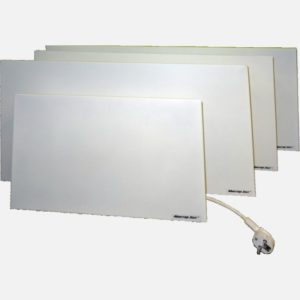
The increase in temperature of ceramic panels occurs due to electric heating elements built into the ceramics.
Gas ceramic heaters
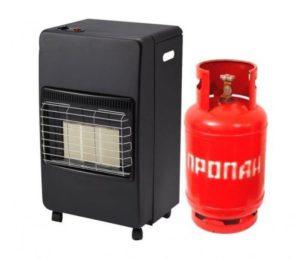
In gas models, the panels are heated due to the energy released during the combustion of natural or bottled gas.
Thermal energy is converted into infrared radiation using reflectors. To ensure that the heat is directed, reflectors are used - metal plates.
Almost all models of heaters can operate on natural and bottled gas. Changing the gas source is achieved by changing the adapter.
The design is designed to prevent flashing when ignited. The gas ceramic heater is provided with a valve system and control unit for safety.
Features of ceramic heaters
The devices are unique in their combination of infrared and convection heating methods. This allows you to reduce financial costs for the heat source.
When purchasing, you should pay attention to some points.
Different types of accommodation
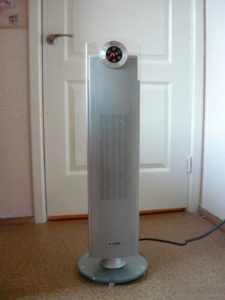
The most effective in terms of heat transfer are floor-mounted ones, but they can get in the way in a small room, despite their mobility. The presence of legs allows you to rearrange them in a convenient place.
Wall-mounted ones are mounted on the wall using brackets, fit perfectly into the interior of any room, and do not take up additional space.
Tabletop models are used for local heating of part of the room.
Ceiling heaters, on the other hand, cover a large space. IR radiation heats up the floor and objects below, which then give off heat.
Device power
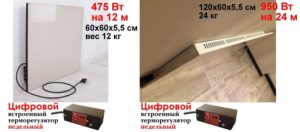
Depends on the area of the heated room, or more precisely, on its volume.
Given the same area, a room with high ceilings takes longer to warm up and needs more power.
Reference. It is generally accepted that for 10 sq. m of area requires 100 W.
Manufacturers of ceramic heaters claim that due to the energy efficiency of such devices, 10 W is sufficient. For large areas I install several powerful panels.
All models heat the panel to a certain temperature set by the manufacturer, then the heat source is turned off.
For ease of use, thermostats-programmers are installed. With their help, temperatures that change throughout the day will be maintained, allowing for rational use of resources. For example, during the day, when there is no one at home, there is no need for +22 ° C, you can set a lower temperature.
Advantages of electric and gas ceramic heaters

The advantages of ceramic panels are as follows.
- Compactness.
- Easy to use, do not require complex installation.
- Energy efficiency.
- Comfort of use.Additional features, such as remote control and some others, increase ease of use.
- Universal stylish design. All manufacturers offer several colors. This allows for use in rooms of various purposes and styles.
Disadvantages of electric and gas ceramic heaters
The main disadvantage of this type of heaters is the high price.
The cost of domestic ceramic panels is comparable to the best models of recognized world-class brands.
Ceramic heaters are new generation devices. They are simple and effective, versatile and comfortable. Despite the high price, they received consumer recognition. It is the cost that is the limitation for wider distribution.





